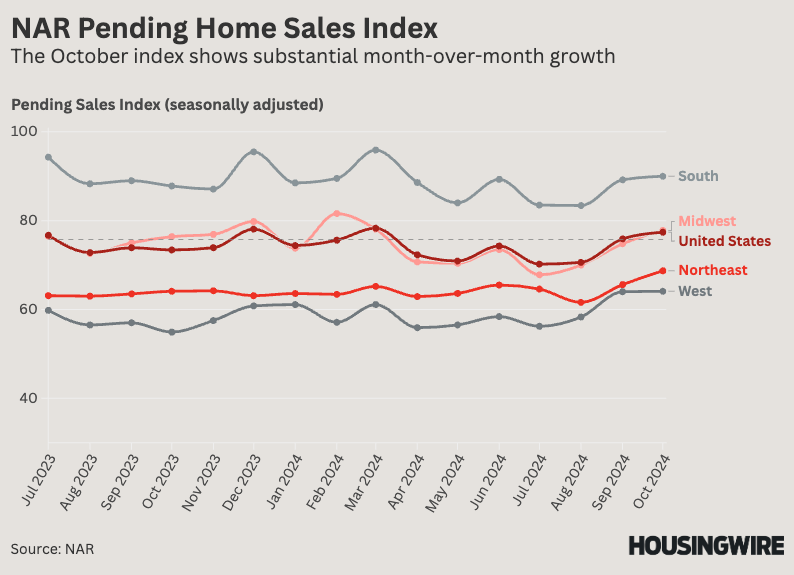Despite the recent rise in mortgage rates, early indicators suggest that the housing market is pointed in the right direction. The latest signal comes from the National Association of Realtors‘ (NAR) Pending Home Sales Index (PHSI), which shows sales in October growing 5.4% year over year and 2% compared to September.
The 77.4 reading for the PHSI is the highest mark since March and the third highest dating back to December 2023. The PHSI is benchmarked at 100 in 2001.
“Homebuying momentum is building after nearly two years of suppressed home sales,” NAR chief economist Lawrence Yun said in a statement. “Even with mortgage rates modestly rising despite the Federal Reserve‘s decision to cut the short-term interbank lending rate in September, continuous job additions and more housing inventory are bringing more consumers to the market.”
Breaking the index down geographically reveals more good news as the PHSI rose substantially in all four regions of the country.
On a month–over-month basis, pending sales in the West grew the most at 9.8%, followed by the Midwest (+7.1%), the South (+6.7%) and the Northeast (+6.5%). Pending sales in the West also grew 12.3% year over year. The Northeast posted an annual growth rate of 3.3% while the Midwest and South were flat.
“The October pending sales data is a sign that fourth-quarter sales will be strong enough so that 2024 sales end up higher than 2023,” Bright MLS chief economist Lisa Sturtevant said in a statement. “However, there are headwinds. Higher mortgage rates mean that some buyers might decide to wait until 2025.”
The positive PHSI reading comes on the heels of NAR’s existing-home sales report for October, which showed sales hitting a seasonally adjusted annual rate of 3.96 million. While that rate is well below historic averages, the 2.9% year-over-year growth is the first annualized increase since July 2021.
The October new-home sales data from the U.S. Census Bureau was less encouraging. Sales last month came in at a seasonally adjusted annual rate of 610,000, a 9.4% year-over-year decline. The decline is largely attributable to a huge pullback in the South, which easily accounts for the most new-home sales. That decline is due in part to the recent hurricanes and rising mortgage rates.

